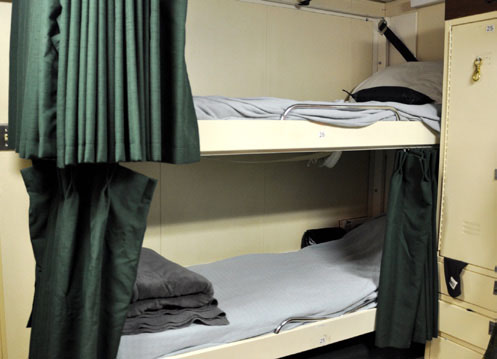Jackspeak: Racks, Pits and Carts
By Lookout Production on Nov 25, 2022 with Comments 0
Mark Nelson
—
Every sailor needs a comfortable place to sleep to maintain their peak efficiency, but more importantly, to preserve the twinkle inherent in their eyes.
Sailors sleep in a mess, sometimes referred to as a mess deck. A mess is a space filled with bunks, often called racks. The rack owner might refer to their happy resting place as their pit, i.e., ‘I am heading to my pit for the night’. Pit is an appropriate term for a bed that bows down in the center and keeps a tired body steady while the ship rocks. Cart is another nickname for a bunk, derived from a mid-19 century military name for a bed.
Someone who spends an inordinate time in their rack might be referred to as a rack monster or pit monster, i.e., ‘Bloggins, the pit monster, will catch some zees anytime he sees his cart’. Zees is used to describe good sleep. ZizEX might describe a decent nap session, making an off-hand reference to snoring.
Before the introduction of bunks fitted in the
St. Laurent-class destroyers (launched in the 1950s-60s), mess decks were outfitted with mick bars (short for ‘hammock’), which were notched metal bars mounted strategically on the bulkhead and deckhead. These bars provided strong points where hammocks could be affixed. During quiet hours, sailors would snore away, swinging their micks in unison with the ship’s rolling. In the morning, the pipe ‘Lash up and Stow’ would indicate it was time to put the hammocks aside for the daily routine.
A hammock consisted of a six-foot canvas with grommets at both ends for securing the clews and a thin mattress inside for extra warmth and comfort. The clews consisted of two lanyards, each spliced to a metal ring, and each ring carrying eight nettles connected to the grommets on the hammock. Sailors would often add a mick stick, a notched piece of wood, often a portion of a hockey stick, to help spread out the head of the hammock.
In the past, a deceased sailor would be sewn into their hammock along with weight to help the body sink. There is a bit of folklore regarding the practice of preparing a body for burial at sea, and it states that the sailmaker would stitch the body inside their hammock and make the last stitch through the nose of the deceased. The reason for this step was to confirm the sailor was, in fact, dead, as the pain would awaken the sailor in case a mistake had been made. This tradition is a common tale and often shared in fiction, such as in the Aubrey–Maturin or Horatio Hornblower nautical book series. The story has been passed for generations, however, there is little evidence that it ever actually occurred.
In nautical parlance, the term clew also refers to the corner of a sail. Traditionally, a ship with its sails clewed up is ready to set the sails and catch the wind. Today, a person who is clewed up is someone prepared to go forth. There is a special time when this term is used, and it is when a sailor is getting married, i.e., ‘Bloggins is getting clewed up this Saturday’. Congratulations, Bloggins!
You will find over 4,000 examples of Jackspeak in my book Jackspeak of the Royal Canadian Navy (2nd ed.).
The author of ‘Jackspeak of the Royal Canadian Navy’ and ‘Whiskey 601’, Mark Nelson developed a love of the Navy’s language and lifestyle over his 26-year career in the service. After retiring as a Chief Petty Officer Second Class, he now works as a Library Systems Specialist at Red River College Polytechnic in Winnipeg, Man.
Follow Mark on Twitter @4marknelson
Filed Under: Top Stories
About the Author:






